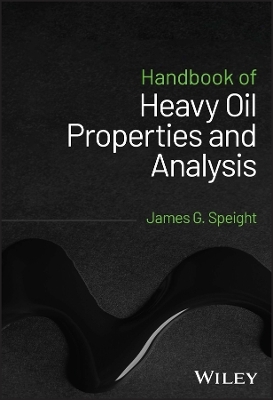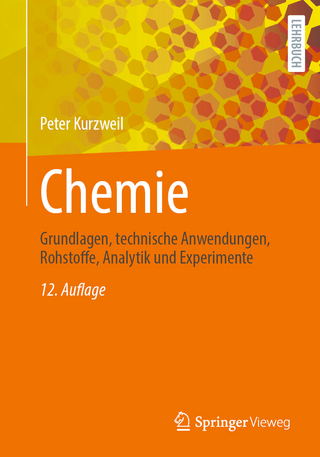
Handbook of Heavy Oil Properties and Analysis
John Wiley & Sons Inc (Verlag)
978-1-119-57715-7 (ISBN)
Heavy oil, also known as viscous oil, is oil too viscous to flow normally from wells and reservoirs. In recent decades it has become increasingly important as a source of liquid oil for use in industrial processes. This places all the greater importance on proper analysis of heavy oil and its properties, so that it can be more effectively refined and deployed to meet ever-growing energy needs.
Handbook of Heavy Oil Properties and Analysis provides a comprehensive introduction to the analysis of viscous oil and its properties. It discusses the full range of tests and analytical procedures by which the behavior and refinability of viscous oil samples can be predicted and connects theoretical knowledge to refinery practice throughout. Additionally, its incorporation of the latest environmental regulations makes it an invaluable resource.
Readers will also find:
Detailed coverage of both physical properties and chemical composition of heavy oil
An author more than fifty years of experience in the process industries
Discussion of new methods for determining instability and incompatibility
This book is a useful reference for scientists and engineers in the oil refining industries, chemists and researchers in heavy oil and adjacent industries, and government officials and regulators.
James G. Speight, PhD, is an independent fuel and environmental consultant with an international reputation for expertise in fuel properties and environmental impacts. He has authored over 100 books and papers and has received numerous awards and distinctions for his research and work in oil refinement and processing.
About the Author
Preface xv
1 History and Terminology 1
1.1 Introduction 1
1.2 Historical Perspectives 8
1.2.1 Pre- Christian Era Use of Heavy Oil and Bitumen 8
1.2.2 Post- Christian Era Use of Heavy Oil and Bitumen 14
1.3 Definitions and Terminology 15
1.3.1 Nonviscous Feedstocks 17
1.3.1.1 Crude Oil 17
1.3.1.2 Opportunity Crude Oil 21
1.3.1.3 High- Acid Crude Oil 25
1.3.1.4 Foamy Oil 26
1.3.2 Viscous Feedstocks 27
1.3.2.1 Gas Oil 29
1.3.2.2 Heavy Crude Oil 30
1.3.2.3 Extra Heavy Crude Oil 33
1.3.2.4 Tar Sand Bitumen 36
1.3.2.5 Residuum 41
1.3.2.6 Asphalt 45
1.3.2.7 Tar and Pitch 49
1.3.2.8 Sludge 50
1.4 Classification 51
1.5 Feedstock Evaluation 53
1.6 Modern Analytical Perspectives 56
References 58
2 Sampling and Measurement 63
2.1 Introduction 63
2.2 Sampling 64
2.2.1 Sampling Protocol 70
2.2.1.1 Sampling Semi- volatile and Nonvolatile Compounds 71
2.2.1.2 Solids 75
2.2.1.3 Extract Concentration 77
2.2.1.4 Sample Cleanup 80
2.2.2 Representative Sample 80
2.2.3 Sampling Error 82
2.3 Measurement 82
2.4 Method Validation 85
2.4.1 Requirements 87
2.4.2 Method Detection Limit 87
2.4.3 Accuracy 88
2.4.4 Precision 89
2.5 Quality Control and Quality Assurance 90
2.5.1 Quality Control 90
2.5.2 Quality Assurance 92
2.6 Assay and Specifications 93
2.6.1 Assay 95
2.6.2 Specifications 99
2.6.3 Metallic Constituents 100
2.6.4 Water Content 101
2.7 Environmental Issues 102
References 104
3 Chemical Composition 109
3.1 Introduction 109
3.2 Elemental Composition 114
3.3 Chemical Composition 120
3.3.1 Hydrocarbon Constituents 122
3.3.1.1 Paraffin Hydrocarbon Derivatives 123
3.3.1.2 Cycloparaffin Hydrocarbon Derivatives 124
3.3.1.3 Aromatic Hydrocarbon Derivatives 124
3.3.1.4 Unsaturated Hydrocarbon Derivatives 124
3.3.2 Non- hydrocarbon Constituents 125
3.3.2.1 Sulfur Compounds 125
3.3.2.2 Nitrogen Compounds 126
3.3.2.3 Oxygen Compounds 126
3.3.3 Metallic Constituents 127
3.3.4 Porphyrins 128
3.4 Chemical Composition by Distillation 131
3.4.1 Vacuum Gas Oil 135
3.4.2 Vacuum Residua 136
3.5 Chemical Composition by Spectroscopy 137
3.5.1 Infrared Spectroscopy 138
3.5.2 Nuclear Magnetic Resonance Spectroscopy 138
3.5.3 Mass Spectrometry 139
3.5.4 Other Techniques 141
References 142
4 Fractional Composition 149
4.1 Introduction 149
4.2 Distillation 151
4.3 Solvent Treatment 152
4.3.1 Asphaltene Separation 156
4.3.1.1 Influence of Solvent Type 158
4.3.1.2 Influence of the Degree of Dilution 160
4.3.1.3 Influence of Temperature 160
4.3.1.4 Influence of Contact Time 161
4.3.2 Fractionation 161
4.3.3 Carbenes and Carboids 163
4.4 Adsorption 164
4.4.1 Chemical Factors 165
4.4.2 Fractionation Methods 166
4.4.2.1 General Methods 166
4.4.2.2 ASTM Methods 172
4.5 Chemical Methods 173
4.5.1 Acid Treatment 173
4.5.2 Molecular Complex Formation 174
4.5.2.1 Urea Adduction 174
4.5.2.2 Thiourea Adduction 176
4.5.2.3 Adduct Composition 176
4.5.2.4 Adduct Structure 176
4.5.2.5 Adduct Properties 178
4.6 The Asphaltene Fraction 179
4.7 Carbenes and Carboids 180
4.8 Use of the Data 182
References 185
5 Chemical Properties 191
5.1 Introduction 191
5.2 Acid Number 193
5.3 Elemental Analysis and Metals 197
5.4 Emulsion Formation 201
5.5 Evaporation 202
5.6 Flash Point and Fire Point 203
5.7 Functional Group Analysis 204
5.8 Halogenation 208
5.9 Hydrogenation 210
5.10 Oxidation 216
5.11 Thermal Methods 219
5.12 Miscellaneous Methods 222
References 223
6 Physical Properties, Electrical Properties, and Optical Properties 229
6.1 Introduction 229
6.2 Physical Properties 233
6.2.1 Adhesion 234
6.2.2 Density, Specific Gravity, and API Gravity 235
6.2.3 Surface and Interfacial Tension 238
6.2.4 Viscosity 239
6.3 Electrical Properties 243
6.3.1 Conductivity 243
6.3.2 Dielectric Constant 244
6.3.3 Dielectric Strength 244
6.3.4 Dielectric Loss and Power Factor 245
6.3.5 Static Electrification 246
6.4 Optical Properties 246
6.4.1 Optical Activity 248
6.4.2 Refractive Index 249
References 250
7 Thermal Properties 255
7.1 Introduction 255
7.2 Ash Production 256
7.3 Carbon Residue 258
7.4 Critical Properties 260
7.5 Enthalpy 262
7.6 Heat of Combustion 263
7.7 Latent Heat 264
7.8 Liquefaction and Solidification 265
7.9 Pour Point 267
7.10 Pressure–Volume–Temperature Relationships 267
7.11 Softening Point 269
7.12 Specific Heat 269
7.13 Thermal Conductivity 271
7.14 Volatility 272
References 278
8 Chromatographic Properties 283
8.1 Introduction 283
8.2 Adsorption Chromatography 286
8.3 Gas Chromatography 291
8.4 Gel Permeation Chromatography 298
8.5 High- Performance Liquid Chromatography 300
8.6 Ion Exchange Chromatography 303
8.7 Simulated Distillation 305
8.8 Supercritical Fluid Chromatography 307
8.9 Thin Layer Chromatography 309
References 311
9 Structural Group Analysis 317
9.1 Introduction 317
9.2 Physical Property Methods 320
9.2.1 Density Method 321
9.2.2 Density–Temperature Coefficient Method 321
9.2.3 Direct Method 322
9.2.4 Dispersion–Refraction Method 323
9.2.5 Molecular Weight- Refractive Index Method 324
9.2.6 n-d-M Method 325
9.2.7 Waterman Ring Analysis 325
9.2.8 Miscellaneous Methods 327
9.3 Spectroscopic Methods 328
9.3.1 Electron Spin Resonance 329
9.3.2 Infrared Spectroscopy 329
9.3.3 Mass Spectrometry 333
9.3.4 Nuclear Magnetic Resonance Spectroscopy 339
9.3.5 Ultraviolet Spectroscopy 345
9.3.6 X- ray Diffraction 345
9.4 Heteroatom Systems 347
9.4.1 Nitrogen 347
9.4.2 Oxygen 348
9.4.3 Sulfur 348
9.4.4 Metals 349
9.5 Miscellaneous Methods 349
References 350
10 Molecular Weight Determination 357
10.1 Introduction 357
10.2 Methods for Molecular Weight Measurement 360
10.2.1 Vapor Pressure Osmometry 361
10.2.2 Freezing Point Depression 365
10.2.3 Boiling Point Elevation 366
10.2.4 Size Exclusion Chromatography 367
10.2.5 Mass Spectrometry 369
10.2.6 Nuclear Magnetic Resonance Spectroscopy 370
10.3 Molecular Weights of Volatile Fractions 370
10.4 Molecular Weights of Nonvolatile Fractions 371
10.4.1 Resins 372
10.4.2 Asphaltenes 372
10.4.3 Carbenes and Carboids 378
References 379
11 Instability and Incompatibility 383
11.1 Introduction 383
11.2 Occurrence of Instability and Incompatibility 389
11.3 Factors Influencing Instability and Incompatibility 394
11.3.1 Acidity 395
11.3.2 Asphaltene Content 395
11.3.3 Density/Specific Gravity 398
11.3.4 Elemental Analysis 398
11.3.5 Metals Content 399
11.3.6 Pour Point 400
11.3.7 Viscosity 400
11.3.8 Volatility 400
11.3.9 Water Content, Salt Content, Bottom Sediment and Water (BS&W) 402
11.4 Determination of Instability and Incompatibility 403
References 406
12 Use of the Data 413
12.1 Introduction 413
12.2 Use of the Data 414
12.3 Process Analysis and Feedstock Mapping 416
12.3.1 Property Predictions 418
12.3.2 Predicting Separations 418
12.3.3 Process Predictability 419
12.4 Environmental Aspects of Processing 419
12.4.1 Gaseous Emissions 422
12.4.2 Liquid Effluents 428
12.4.3 Solid Effluents 430
12.5 Analytical Methods for Environmental Regulations 431
12.5.1 Definitions 432
12.5.2 Environmental Regulations 434
12.5.3 Environmental Analysis 435
References 437
Glossary 441
Conversion Factors 467
Index 469
| Erscheinungsdatum | 17.08.2022 |
|---|---|
| Verlagsort | New York |
| Sprache | englisch |
| Gewicht | 1238 g |
| Themenwelt | Naturwissenschaften ► Chemie ► Technische Chemie |
| Technik | |
| ISBN-10 | 1-119-57715-2 / 1119577152 |
| ISBN-13 | 978-1-119-57715-7 / 9781119577157 |
| Zustand | Neuware |
| Informationen gemäß Produktsicherheitsverordnung (GPSR) | |
| Haben Sie eine Frage zum Produkt? |
aus dem Bereich


